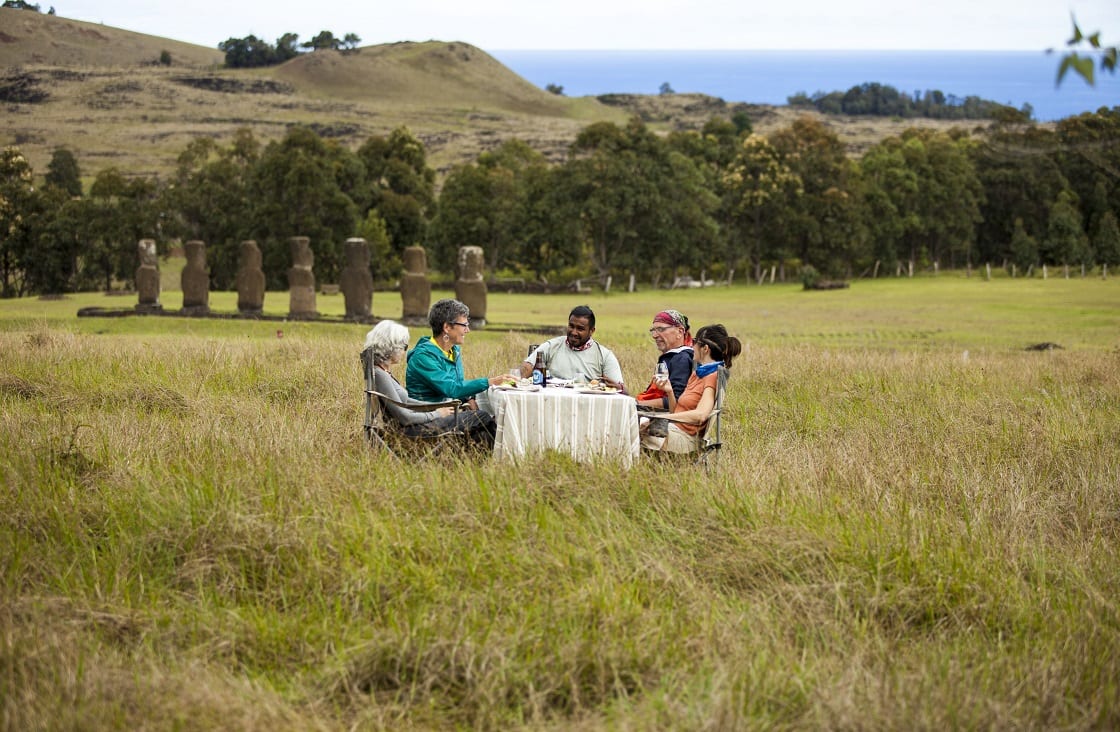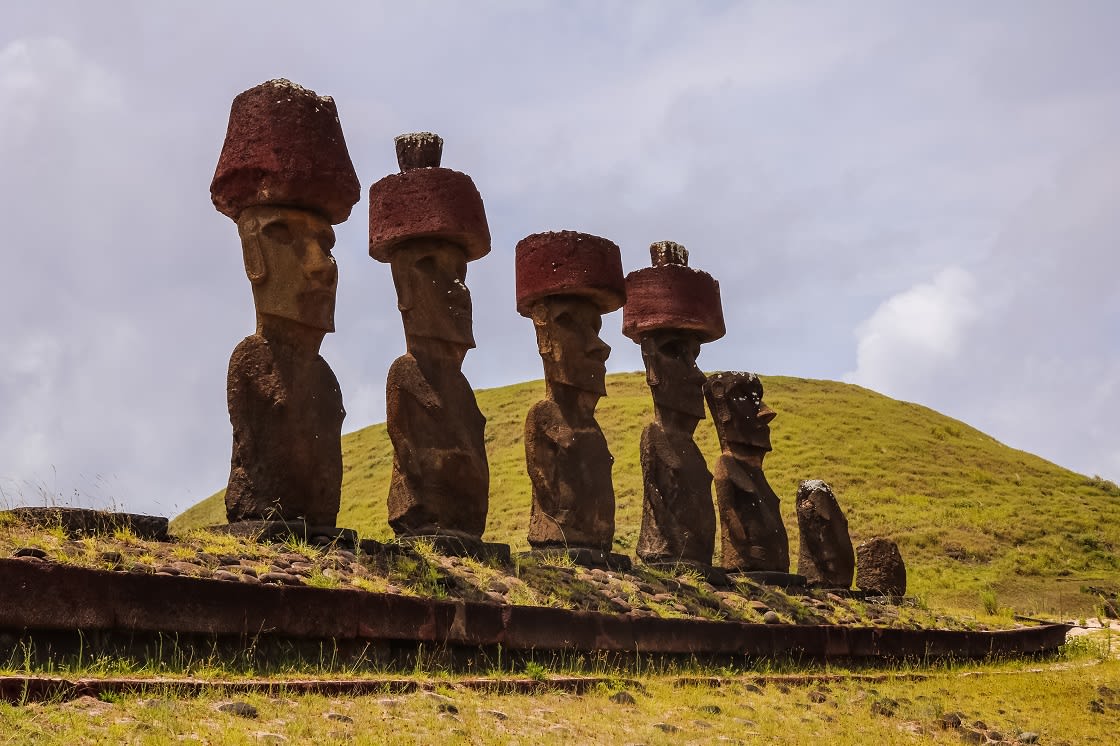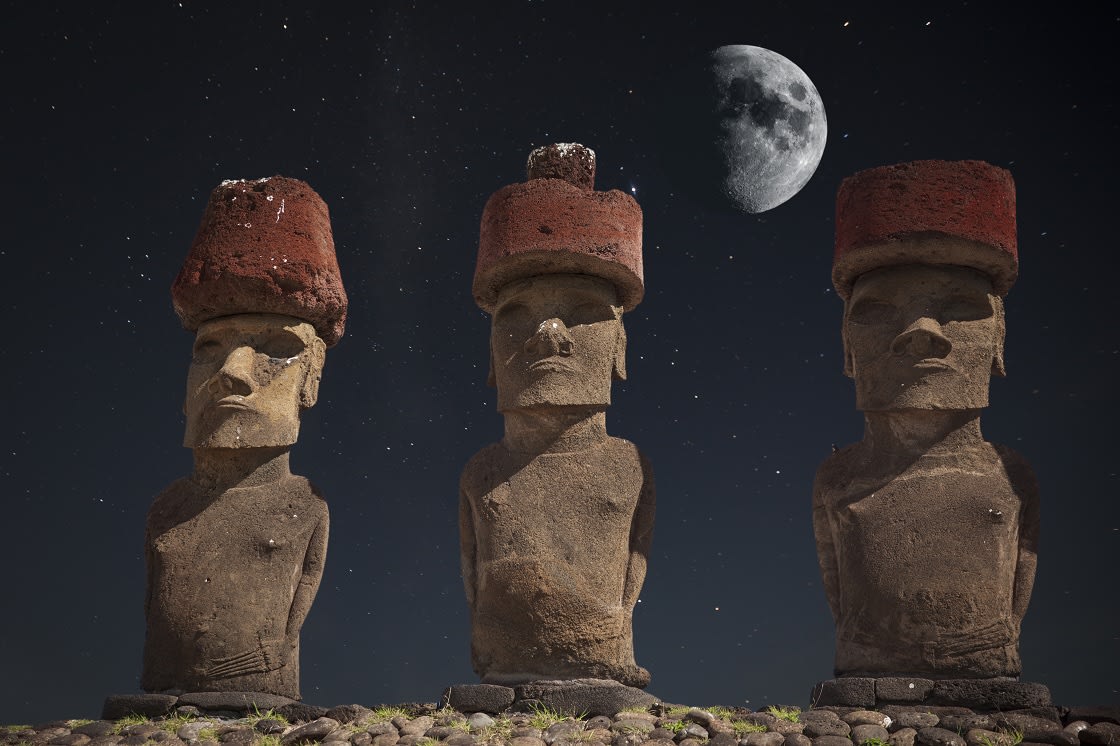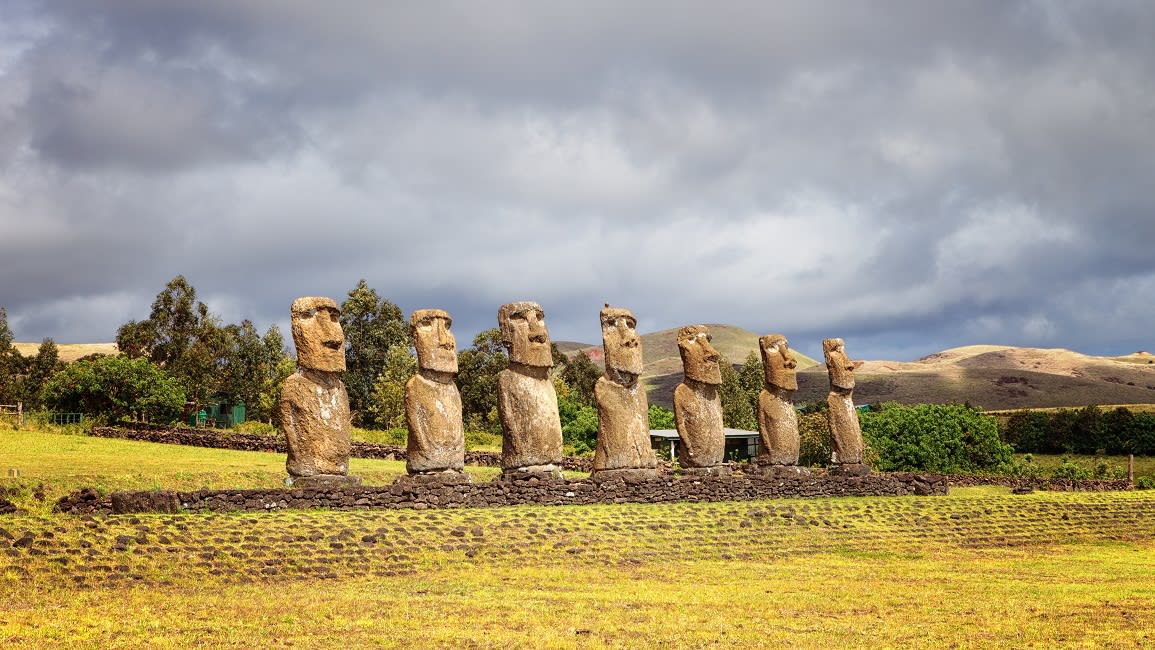
Located at the far eastern point of Polynesia in the middle of the Pacific Ocean, Rapa Nui is a place that has long been shrouded in mystery. For decades the allure of this volcanic island, the most isolated inhabited place on earth, has been attracting visitors who are curious to discover the gorgeous scenery and intriguing statues.

Ahu Tongariki
One of the most rewarding things to do in Easter Island, Chile, is to watch the sunrise over the 15 moai at Ahu Tongariki, which is home to the best-restored moais on the island. Re-erected to their traditional positions after a huge tsunami knocked them down in 1960, the 15 moai stand tall with spectacular mountains and ocean views behind them. While visiting Ahu Tongariki is beautiful at any time of day, being there for sunrise is especially captivating as the sun comes up between the statues, throwing long shadows across the field. Stay as long as you can after the sun rises to capture some amazing shots once everyone else has left.
Almost completely covered in floating totora reeds, the crater lake of Rano Kau resembles an enormous witch’s cauldron and is a wild greenhouse of endemic biodiversity. Perched 1000 feet above the lake, on the rim of the crater wall on one side and adjacent to a vertical drop on the other side, which plunges down to the ocean, Orongo Ceremonial Village rests in one of the South Pacific’s most breathtaking landscapes. It overlooks several small offshore islands. Built into the side of the slope, the village houses have walls of horizontally overlapping stone slabs. Each has an earth-covered arched roof of similar materials, making them appear partly subterranean. Orongo was the focus of a ‘birdman cult’ in the 18th and 19th centuries, which was a visible expression of islandwide political competition and cooperation. Birdman petroglyphs are visible on a cluster of boulders between the clifftop and the edge of the crater.

Moais At Anakena Beach
While most of the coastline of Rapa Nui is rocky due to the volcanic composition of the island, Anakena is a picture-postcard-perfect, white-sand beach bordered by soaring palm trees. It also forms a lovely backdrop for Ahu Nau Nau, which comprises seven moai, some with topknots. On a rise to the south of the beach stands Ahu Ature Huki and its lone moai, which was re-erected by Norwegian explorer Thor Heyerdahl with the help of a dozen islanders in 1956. Headlands on either side of the bay present glorious views while also creating a protective shelter for the waves that lap the shore.
Easter Island is an ideal place for diving and snorkeling because the waters are so clear and transparent that visibility can reach up to 200 feet. This unique characteristic is due to the absence of plankton and pollution. Immersing yourself in this part of the Pacific is certainly a fascinating adventure that will take you through a stunning underwater volcanic landscape. The seabed is littered with caves, arches, cliffs, and lava platforms and there is even an underwater moai, albeit not authentic − it was installed on the reef for a movie, but makes for some great underwater photos. Every day, the gorgeous Hanga Roa harbor fills up with remarkable marine life, including the sea turtles that come out to play in the rolling current. It offers awesome snorkeling and is best at high tide.
Iglesia Hanga Roa, the island’s Catholic church, is well worth a visit for its spectacular carvings, which integrate Christian doctrine with Rapa Nui tradition. It also becomes a colorful scene on Sunday mornings.

Moais At Night Under The Light Of Stars
The remote location of Rapa Nui means that it is one of the most phenomenal places to admire the night sky. When the sun sets the stars come out in all their glory and you will be astounded by the clarity of the overhead scene.
There’s nothing better than having the freedom to go at your own pace in a rented car. Wake up early and make your way out to Ahu Tongariki for sunrise, then head to the beach or take random roads and see where you end up while stopping at any of the marvelous lookouts scattered around the island. It’s also possible to rent bicycles, ATVs, or dirt bikes.
Easter Island is a mecca for surfers and found its way onto the surfing radar in the early ’90s. The best time of year to surf here is during January and February when the crystalline swell rolls in under a cloudless sky. However, you can have fantastic waves at any time of year, while the harbor at Hanga Roa gets some gentle, rolling sets that are perfect to learn on.
Easter Island’s only museum showcases preserved artifacts that have been found on the island including obsidian stone tools, ancient fish hooks, and weapons, circular beehive-shaped huts, petroglyphs, funerary cists, as well as the face of a moai with a coral eye, which was discovered on Anakena Beach during the restoration of Ahu Nau Nau. The museum also features replica Rongorongo tablets, of which only a few have survived, covered in rows of tiny symbols resembling hieroglyphs that to this day have yet to be deciphered.
Exploring the quarry at Rano Raraku is one of the most interesting things to do on Easter Island. Located on the edge of the Terevaka volcano on the north end, and known as ‘the nursery,’ this is the quarry for the hard tuff from which the moai were cut. You’ll feel as though you’re stepping back into early Polynesian times, wandering among dozens of moai in all stages of construction, from barely carved out to fully completed, yet abandoned, on the side of the volcano. At the top, is an epic 360-degree epic vista out to sea. Within the crater is a small, glistening lake and about 20 standing moai. Look for the kneeling Moai Tukuturi; it has a full body squatting on its heels, with its forearms and hands resting on its thighs.
Rapa Nui is covered in dozens of underground chambers. Ana Kakenga cave has two openings that expose themselves at the side of a cliff, offering sensational views over the Pacific Ocean. This cave is not for the claustrophobic. You need to climb down a narrow entrance to get in, then crawl through a small chamber to reach the openings. Try to be there for sunset, as the cave faces west.
Music and dancing are very important to the people of Polynesia, and Rapa Nui is no exception. The visually inspiring dance shows last for up to 90 minutes and often get the audience involved with the dancing.
Horses wander around freely on Easter Island, and horse riding here is a fun and energetic way to spend a few hours of exploration.
Swing by the local post office in Hanga Roa and stamp your passport with a unique moai statues stamp. The stamp doesn’t have any legal influence, it’s just for fun. Obtaining a stamp is free of charge, although a small tip will gladly be accepted.

Ahu Akivi Was The First Moai Restored
Contrary to popular belief, the moais of Easter Island don’t stare out to sea, but rather look inland. They were built to look back at the villages they represented. The only exception to this is Ahu Akivi, which does stare out at the ocean. This is because the village was built on the edge of the sea, and with no room to place the ahu (platform) in the standard place, the villagers placed it behind.
The thing that captivates visitor’s attention the most is usually how the Rapa Nui people moved the statues from the quarry to their final resting places. But not a lot of thought goes into how they carved these huge pieces of stone. One place that will make you think long and hard about that is Ahu Vinapu. Here you will find massive blocks of stone carved so intricately and pieced together so tightly that you can’t even insert a knife between them.
While Rainforest Cruises aim to provide accurate and up-to-date information, we make no representations as to the accuracy or completeness of any information herein or found by following any link on this site. Rainforest Cruises cannot and will not accept responsibility for any omissions or inaccuracies, or for any consequences arising therefrom, including any losses, injuries, or damages resulting from the display or use of this information.




